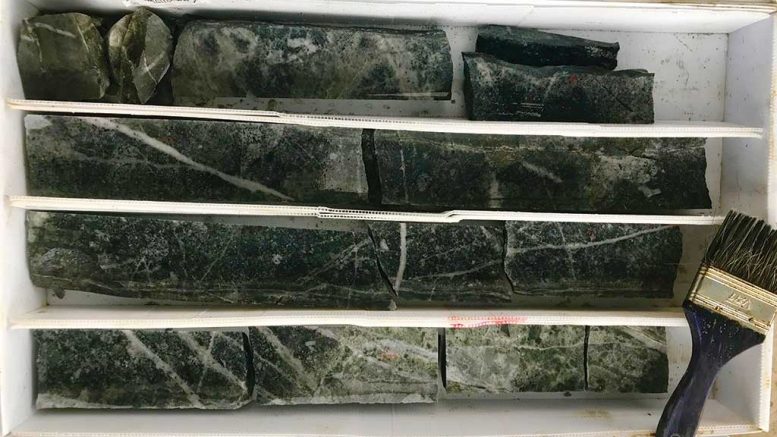Lumina Gold (TSXV: LUM; US-OTC: LMGDF) has announced drill results from the Gran Bestia zone at its Cangrejos gold project in Ecuador that, along with drilling by the property’s previous owner, confirm a second deposit that could boost the project’s scale.
“It’s early days here right now, but we’re pretty optimistic about what we’re seeing so far, mineralization-wise,” Lumina president and CEO Marshall Koval says in an interview with The Northern Miner.
The company found long intervals of gold mineralization in its first three holes at Gran Bestia, including 0.44 gram gold tonne and 0.12% copper over 262 metres from surface, and 0.41 gram gold with 0.1% copper over 26 metres from 274 metres downhole.
“All indications are that it’s an impressive deposit,” Koval says. “Gran Bestia could be a satellite deposit that is an initial starter pit if it pans out, or it could add to the mine life at Cangrejos, from a resource perspective.”
The company is still drilling Gran Bestia. It sits 1 km from the Cangrejos deposit. The three holes Lumina drilled last year at Gran Bestia join five others from the property’s previous owner, Newmont Mining (NYSE: NEM).
“Our follow up confirmed what Newmont saw initially there,” Koval says. “And the idea there is to fully test it and understand it. But it’s pretty exciting.”
Highlights from Newmont’s drilling at Gran Bestia include: 0.91 gram gold and 0.16% copper over 209 metres from surface and 0.55 gram gold over 319 metres from surface. Mineralization at Gran Bestia is open in all directions.
The company also drilled southeastern step-out holes from the main resource at Cangrejos. Highlights from those two holes include 0.61 gram gold and 0.11% copper over 28 metres from 242 metres downhole and 0.21 gram gold and 0.1% copper over 36 metres from 22 metres downhole.
Highlights from infill holes the company drilled in the southwest part of the Cangrejos deposit include 0.64 gram gold and 0.15% copper over 366 metres from 170 metres downhole, 0.85 gram gold and 0.25% copper over 294 metres from 2 metres downhole, and 0.54 gram gold and 0.24% copper over 92 metres from surface.
The latest results come from the company’s 2018 drill campaign, where it drilled 12,800 metres across 32 holes at Cangrejos. It also drilled 2,300 metres across seven holes for geotechnical and metallurgical data.
The company has two drill rigs turning at the project and expects two more to arrive in February 2019.
Lumina plans to drill 7,000 metres across 23 infill and step-out holes at the Cangrejos deposit and 5,200 metres across 13 holes defining Gran Bestia this year. It expects to finish resource drilling by early July 2019.
“The only caveat is that what we find at Gran Bestia may extend that schedule, if we’re successful,” Koval says. “We have a soil and rock-chip anomaly that crosses the two areas and we’re going to at some point here — after we understand the mineralization at Gran Bestia a little better — see if those two areas are connected, and if it’s one large deposit, or if it’s truly a satellite deposit by itself.”
The company plans to table an updated resource estimate for the Cangrejos project in the second half of 2019, incorporating all 2018 and 2019 drilling. It will include a maiden resource for Gran Bestia.
The company is also continuing metallurgical and engineering drilling in the first half of 2019. The company plans to drill eight holes for pit slope design and pump tests. It will also monitor wells for hydrogeological studies. The company has shipped 1.8 tonnes of material from 2018 drilling to Lima for metallurgical tests. It intends to ship 2 tonnes of whole PQ core to Utah for high-pressure grinding role tests (HPGR).
“The idea there is you would save operating costs by going to HPGR, because the mineralization is moderate to hard,” Koval says.
Lumina expects to finish its metallurgical testing program by the third quarter.
The company tabled a preliminary economic assessment (PEA) for Cangrejos in mid-2018 detailing a 16-year, open-pit operation that would process 40,000 tonnes per day during its first five years, and 80,000 tonnes per day for the rest of its life.
The project has a US$920-million, after-tax net present value at a 5% discount rate and a 15% after-tax internal rate of return. It would require a US$831-million initial capital expense and US$230 million for life-of-mine sustaining capital.
The project would produce 373,000 oz. gold and 43 million lb. copper on average per year. It contains 408 million inferred tonnes grading 0.65 gram gold per tonne, 0.11% copper, 0.6 gram silver per tonne and 0.0025% molybdenum for 8.5 million oz. gold, 1.03 billion lb. copper, 7.8 million oz. silver and 22.5 million lb. molybdenum.
Shares of Lumina are trading at 56¢ in a 52-week range of 46¢ to 85¢. The company has a $173-million market capitalization. In August 2018, it spun out all its projects — except Cangrejos — into a company called Luminex Resources (TSXV: LR; US-OTC: LUMIF).
“If you drill and you have legitimate targets like Gran Bestia, it’s a good value creator for the company — besides de-risking, engineering and [prefeasibility] fieldwork, as you move on,” Koval says. “We’re kind of doing both simultaneously and trying to fast-track the fieldwork as quick as we can, so we better understand what we have.”


Be the first to comment on "Lumina confirms deposit at Gran Bestia"